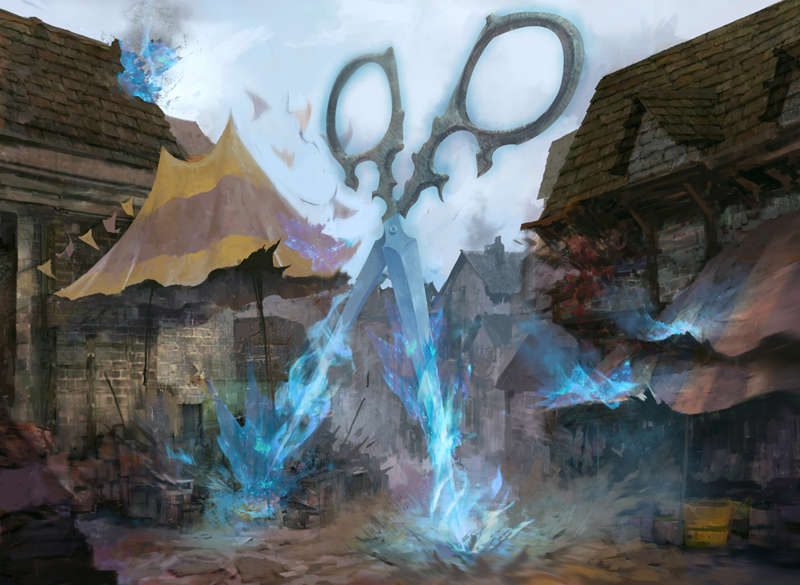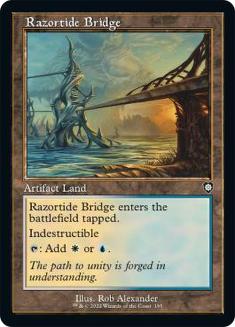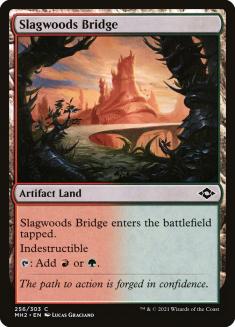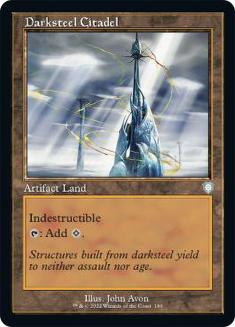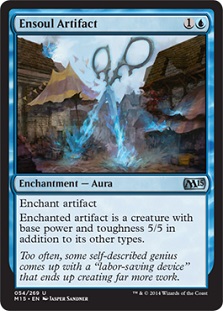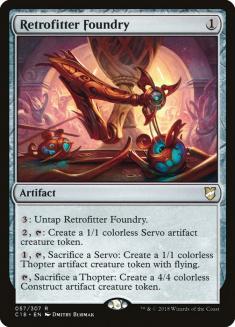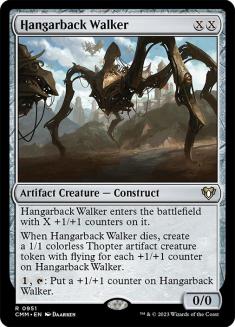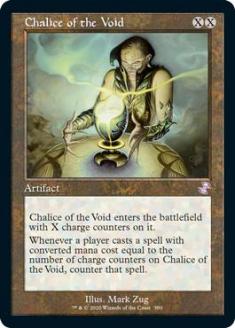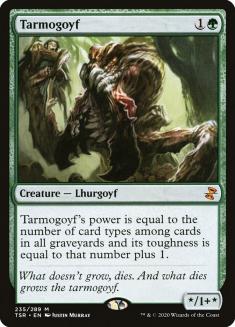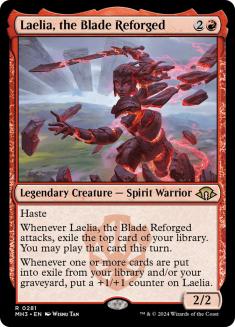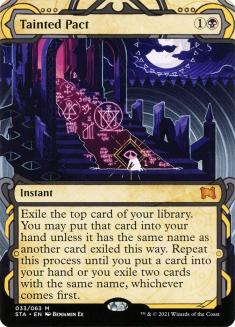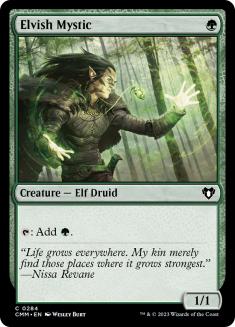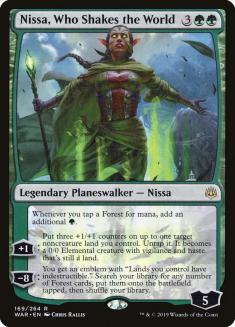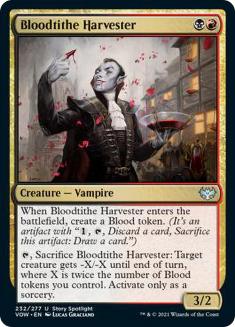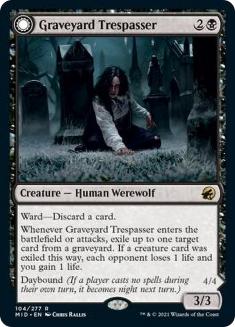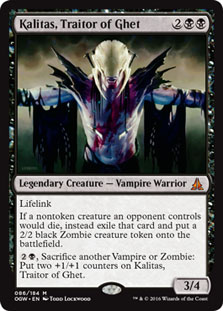Historic is about to change in a big way. The format has been defined by these sudden upheavals, with cards being parachuted in seemingly at random, but was able to rest recently. Both Innistrad sets as well as Kamigawa: Neon Dynasty and Streets of New Capenna offered a steady stream of relevant cards but there hasn’t been a dedicated injection of new Historic cards in quite a while.
Historic Anthology 6 isn’t the only story here, as Explorer Anthology 1 is likely to have a bigger impact on Historic despite being aimed at another format. Both anthologies join a format still recovering from a massive round of rebalancing and other changes as well as new additions from Alchemy Horizons: Baldur’s Gate.
Let’s look at the Historic Anthology first.
A full half of the Anthology is given over to the cycle of ten artifact dual lands from Modern Horizons 2. As with most cycles, we can expect these to have an uneven representation. I’d be shocked to see a Goldmire Bridge in a serious Historic deck but Razortide Bridge is a big pickup for the Azorius Affinity deck that Jean-Emmanuel Depraz put on the map at the Neon Dynasty Championship. More generally, the blue artifact lands make it much easier to start the game with Emry, Lurker of the Loch or work your way towards Thought Monitor.
These decks are assertive, but not aggressive, and they don’t apply pressure on your life total quickly. We can change that with some convenient crossovers from the Explorer Anthology.
The pairing of Ensoul Artifact and Darksteel Citadel had a short window to shine in Standard but was revitalized in Pioneer by Kamigawa: Neon Dynasty. The Bridges give you even more ways to make a giant attacker that’s immune to most removal and you’ll gladly suit up an Ornithopter or Esper Sentinel too.
The indestructible artifact lands can turn Cleansing Wildfire into an incredible ramp spell but it’s hard to build your deck to maximize that extra mana when you only have four copies of this effect. I expect to see that trick a lot on the ladder, though.
Retrofitter Foundry is another incredible tool for artifact decks but it pulls you in a different direction. You can use it aggressively with Ornithopter or Hope of Ghirapur (or Thopter tokens from Sai, Master Thopterist) but Foundry really shines as a grindy tool that lets you play a reactive game before turning the corner quickly.
It’s unclear where Hangarback Walker fits in here. It’s at its best against the same removal that an Ensouled Darksteel Citadel shrugs off but these decks already have a lot of counterplay there. The fact that it’s a generally strong card that’s also an artifact doesn’t count for much when so many good options are available and you have to be able to unlock the Thopter tokens on demand or care about some other aspect of the card.
The artifact-centric Rakdos Sacrifice decks with Oni-Cult Anvil may have some interest (though these take a big hit from Cauldron Familiar being neutered). As ever I’m holding out hope that Hardened Scales can succeed but Hangarback Walker doesn’t fill the void left by Walking Ballista as you can create a formidable battlefield presence but can’t meaningfully interact with the opponent.
Chalice of the Void may be the single most baffling inclusion in any Anthology so far. It’s miserable to play against and not appealing to play with in the absence of fast mana. Outside of Izzet Phoenix (which was cut down to size by the rebalancing of its premiere one-drops) mana curves in Historic are not so compressed that it’s worth trying to lock the opponent out with Chalice and it doesn’t have an equivalent of Modern’s Cascade combo decks to keep in check.
By contrast, Tarmogoyf is a perfect inclusion – an iconic card that’s showing its age and whose power is contextual. We are so used to seeing Tarmogoyf alongside fetchlands and a plethora of cheap spells in Eternal formats that we take its battlefield dominance for granted – in practice, it will be harder to get it to its usual size in other formats and those stats are less impressive now than in 2012 or 2017.
The bigger problem is that it has no obvious home. Classic Modern favourites like Jund Midrange simply don’t exist in the same way in Historic and nor do the tempo decks that turned to Tarmogoyf in Legacy. When Sultai Midrange was briefly dominant in Historic it leaned on threats like Uro, Titan of Nature’s Wrath and Nissa, Who Shakes the World – versatile threats that do everything compared to the narrow and blunt instrument offered by Tarmogoyf.
Laelia, the Blade Reforged is the best card that most people have never heard of. If you dabble in Cube, you have an idea of its power and it’s often seen attacking on Turn 1 in Legacy via Ancient Tomb and other fast mana but this is its debut in a more rational Constructed format. As a normal threat, it shares Tarmogoyf’s lack of purpose – but we can aim much higher.
Creatures (6)
- 1 Kalitas, Traitor of Ghet
- 1 Bonecrusher Giant
- 2 Laelia, the Blade Reforged
- 1 Graveyard Trespasser
- 1 Ledger Shredder
Planeswalkers (3)
Lands (23)
- 1 Swamp
- 1 Snow-Covered Island
- 1 Watery Grave
- 1 Steam Vents
- 1 Blood Crypt
- 1 Drowned Catacomb
- 1 Sulfur Falls
- 1 Spirebluff Canal
- 1 Fetid Pools
- 1 Canyon Slough
- 1 Fabled Passage
- 1 Clearwater Pathway
- 1 Riverglide Pathway
- 1 Blightstep Pathway
- 1 Hive of the Eye Tyrant
- 1 Hall of Storm Giants
- 1 Shipwreck Marsh
- 1 Haunted Ridge
- 1 Stormcarved Coast
- 1 Forsaken Crossroads
- 1 Otawara, Soaring City
- 1 Takenuma, Abandoned Mire
- 1 Xander's Lounge
Spells (28)
- 1 Mountain
- 1 Island
- 1 Opt
- 2 Tainted Pact
- 1 Thoughtseize
- 1 Inquisition of Kozilek
- 1 Anger of the Gods
- 1 Kolaghan's Command
- 1 Fatal Push
- 1 Crash Through
- 1 Thought Erasure
- 1 Ritual of Soot
- 1 Tyrant's Scorn
- 1 Cling to Dust
- 1 Shark Typhoon
- 1 Eliminate
- 1 Bloodchief's Thirst
- 1 Spikefield Hazard
- 1 Expressive Iteration
- 1 Unholy Heat
- 1 Consider
- 1 Davriel's Withering
- 1 Galvanic Iteration
- 1 The Celestus
- 1 Memory Deluge
- 1 Fable of the Mirror-Breaker
- 1 Strangle

Tainted Pact took over Historic when Strixhaven’s Mystical Archive was released and earned a swift ban for its partner-in-crime, Thassa’s Oracle. Jace, Wielder of Mysteries is a replacement of sorts but difficult to cast or protect and not a card you’re happy to play in its own right.
Laelia fills that void as a combo piece, as Tainted Pact exiles each card separately, letting you throw away most of your library to create a lethal Laelia instantly, while still being the perfect threat for fair games. This new iteration of Grixis Pact won’t be the dominant force we saw last year but I’m hopeful it can bring its unique variety to Historic again.
One of the most important additions to Historic is a familiar face from the Explorer Anthology:
As I explained last week, Elvish Mystic isn’t just more copies of Llanowar Elves, as that redundancy lets you make big deckbuilding commitments.
Creatures (34)
- 4 Llanowar Elves
- 3 Scavenging Ooze
- 3 Thalia, Guardian of Thraben
- 4 Elvish Mystic
- 4 Lovestruck Beast
- 4 Skyclave Apparition
- 4 Kazandu Mammoth
- 2 Elite Spellbinder
- 2 Brutal Cathar
- 4 Inquisitor Captain
Lands (14)
Spells (12)

This throwback to the fair, non-tribal Selesnya Company decks of old is only possible because you have that Turn 1 Elf more often now. These mana creatures let you pad your curve with more three-drops to support Collected Company and Inquisitor Captain.
Any of these new or revived strategies have to pass the format’s existing litmus tests. Those pillars have been the same for quite some time – Cauldron Familiar, Arclight Phoenix, and Teferi, Hero of Dominaria – but two of them took a body blow with the latest round of rebalancing.
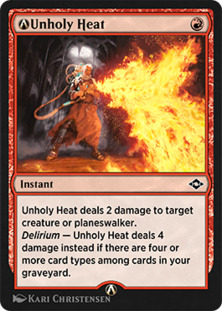
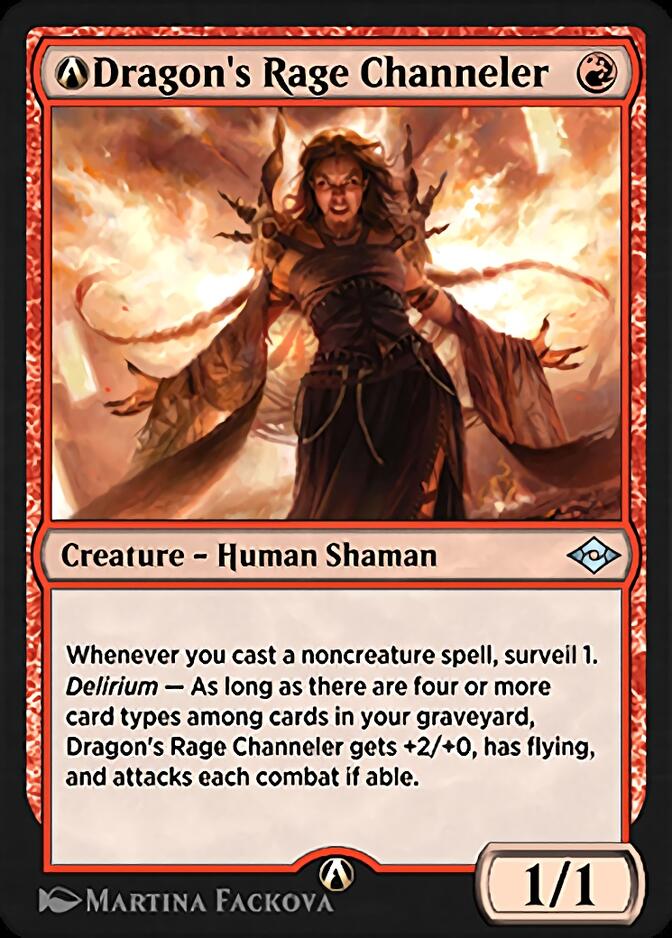
Ragavan, Nimble Pilferer is thankfully absent from Historic, but the rest of that red one-drop trio from Modern Horizons 2 took Izzet Phoenix to the next level in Historic. Dragon’s Rage Channeler still functions similarly but is easier to contest in the air now (with a smaller Shark Typhoon token or Thopter token, for example) – the real game-changer is Unholy Heat. As in Modern, the printing of Unholy Heat was a mass extinction event for expensive cards that died to it. The cards among those that don’t die to this delirium-enhanced weaker version get another chance to prove themselves.
They may have to be careful what they wish for. The threat of Unholy Heat was a convenient excuse for cards that were being pushed out of the format anyway to seek early retirement. Nissa, Who Shakes the World is a perfect example – a format-defining card for most of 2020, but the decks it powered began to vanish as Historic experienced repeated earthquakes. I expect Nissa itself to have a minor resurgence, especially with eight copies of Llanowar Elves rolling out the red carpet for it, but I think it’s likely Unholy Heat was the nail in the coffin rather than the sole culprit in its demise. As the format changes, our expectations ought to as well.
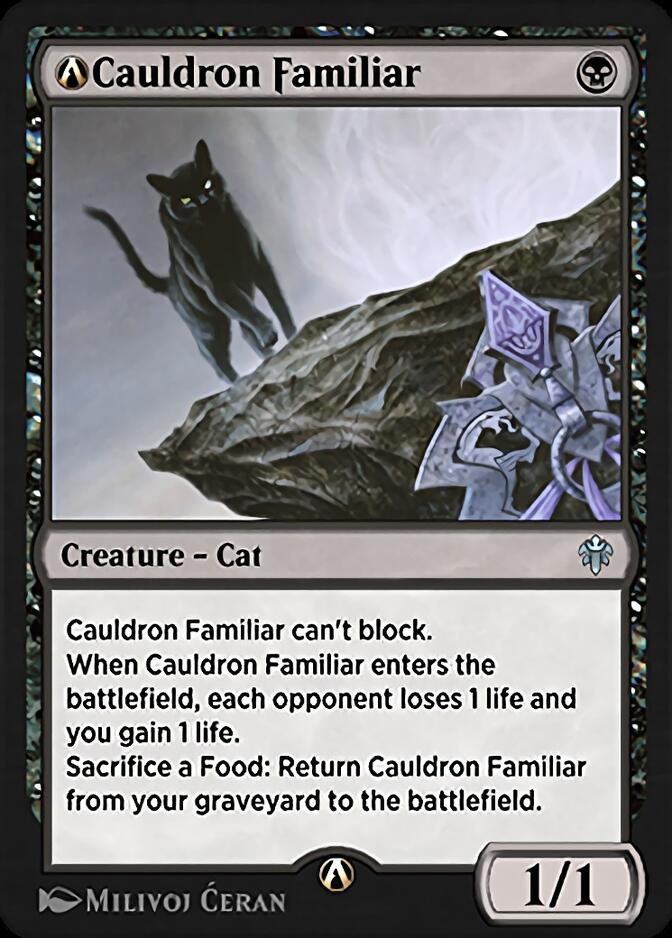
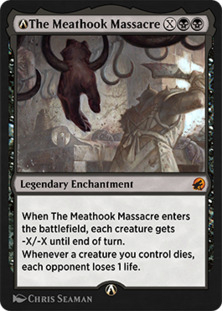
Meanwhile, I’m thrilled to see Cauldron Familiar neutered. Sacrifice decks as a broad archetype are the longest-standing pillar of Historic from its earliest days and Golgari Food was the most successful deck in Historic over the last season of Set Championships. That would be fine if its play patterns were enjoyable but Cauldron Familiar and Witch’s Oven was uniquely excruciating to play with and against. My only complaint is that this didn’t happen sooner.
The combination of Familiar + Oven, The Meathook Massacre, Ravenous Squirrel rapidly outsizing any ground creatures, and incidental lifegain from Food tokens made Golgari Food oppressive for creature decks trying to win through combat. Power and toughness matters again in Historic in a way it hasn’t in a long time.
Selesnya Humans came back in force at the New Capenna Championship, boasting strong matchups across the board – except Golgari Food. We may see the format cycle back to its state going into the Innistrad Championship, where Humans was the deck to beat and a litmus test in its own right.
The other big beneficiary is fair midrange such as the Rakdos decks that are all the rage in Pioneer and Explorer. These decks have a lot of good tools – including Kalitas, Traitor of Ghet as of this Explorer Anthology – but struggled to ever beat a Trail of Crumbs. Thoughtseize and Fatal Push may be back on the menu now.
If Historic is about anything, it’s about change. This perfect storm of new cards and surgical changes will hopefully revitalize interest in a format that has lost its way.

